This article has been
cited by other articles in ScienceCentral.
Abstract
Acute compartment syndrome occurs when pressure increases within closed compartments due to injuries causing soft tissue damage. Delayed treatment can lead to undesirable consequences. This paper reports a three-year-old patient in whom a fasciotomy was performed successfully despite the potential side effects. Fasciotomy may be considered when the diagnosis and clinical symptoms of delayed compartment syndrome are clear. This study determined that the three-year-old patient would undergo a relatively smooth recovery compared to elderly patients of advanced age. Because the dorsalis pedis artery pulse was palpable, an emergency surgical treatment was performed to restore the damaged tissues and prevent further necrosis. The patient has shown a satisfactory recovery.
Go to :

Keywords: Foot, Compartment syndrome, Fasciotomy, Pediatrics, Wounds and injuries
Acute compartment syndrome occurs when pressure increases within closed compartments due to injuries causing soft tissue damage. The condition causes pain and swelling due to impaired blood circulation, and requires immediate orthopedic attention. For early diagnosis of acute compartment syndrome, a fasciotomy and immediate depressurization must be performed. Delayed treatment of compartment syndrome can lead to ischemic necrosis, muscle contracture, nerve damage, amputation, impaired liver function, and even death.
1,2)
Compartment syndrome causes severe irreversible tissue changes. Nerve function is impaired in 30 minutes after ischemia, and irreversible nerve damage occurs within 12 to 24 hours after ischemia. Muscle abnormalities and irreversible damage occur 2∼4 hours and 4∼12 hours after ischemia, respectively.
3) Resulting functional nerve impairment occurs in the early period after the onset of compartment syndrome. Irreversible tissue damage occurs at 12 hours after the onset and results in nerve damage, muscle necrosis, ischemic contracture, inflammation, and delayed fracture union.
4,5) Volkmann ischemic contracture refers to the final stage of compartment syndrome that could not be treated leading to muscle necrosis and ischemic contracture.
6) Myoglobin isolation may result from muscle damage, which can subsequently lead to acute renal failure and acidemia and hyperkalemia causing cardiac arrhythmia and eventually death.
7) Reis and Better
8) reported higher infection contraction and mortality rates among patients suffering lower limb compartment syndrome with treatment delayed for over 24 hours who underwent fasciotomy compared to those who did not. We, hereby, report a case in which a fasciotomy was performed well on an injured foot despite the risks of associated with the procedure regarding patient conditions and symptoms. Literature review is also presented in this case report.
Go to :

CASE REPORT
The protocol of this study was approved by the Institutional Review Board (IRB File no. 2020-02-008) and was performed in accordance with the principles of the Declaration of Helsinki. Since this was a retrospective study, the requirement for informed consent was waived.
A 3-year-old boy, 5 days before his visit, was treated with conservative treatment at a local hospital due to a crush injury in the left foot by a concrete roll under the ladder. During follow-up, he showed left foot pain, worsening of the lesion, and fever. He was admitted to our hospital’s emergency room on the 4th day after injury. At the time of admission, the patient had an acute condition, and the vital signs were blood pressure 100/60 mmHg, pulse rate 157 times per minute, respiratory rate 28 times per minute, and body temperature 37.7℃. Pain, tenderness, swelling, blisters, and necrosis were found in the anterolateral area of the left foot (
Fig. 1), and blood circulation of the 3rd, 4th, 5th limbs was decreased. It was difficult to confirm the comparison of sensory ability with healthy side, and the motor ability was normal. The pulse of the left dorsalis pedis artery was palpated normally. Peripheral blood tests at the time of visit showed leukocyte 17,890/μL, erythrocyte sedimentation rate 120 mm/hour, high-sensitivity C-reactive protein 25.9 mg/L, creatine kinase 3603 IU/L, and myoglobin 480 ng/mL. Simple radiography showed no specific findings, but computed tomography showed a linear fracture posterior to the sustentaculum tali of the calcaneus (
Fig. 2).
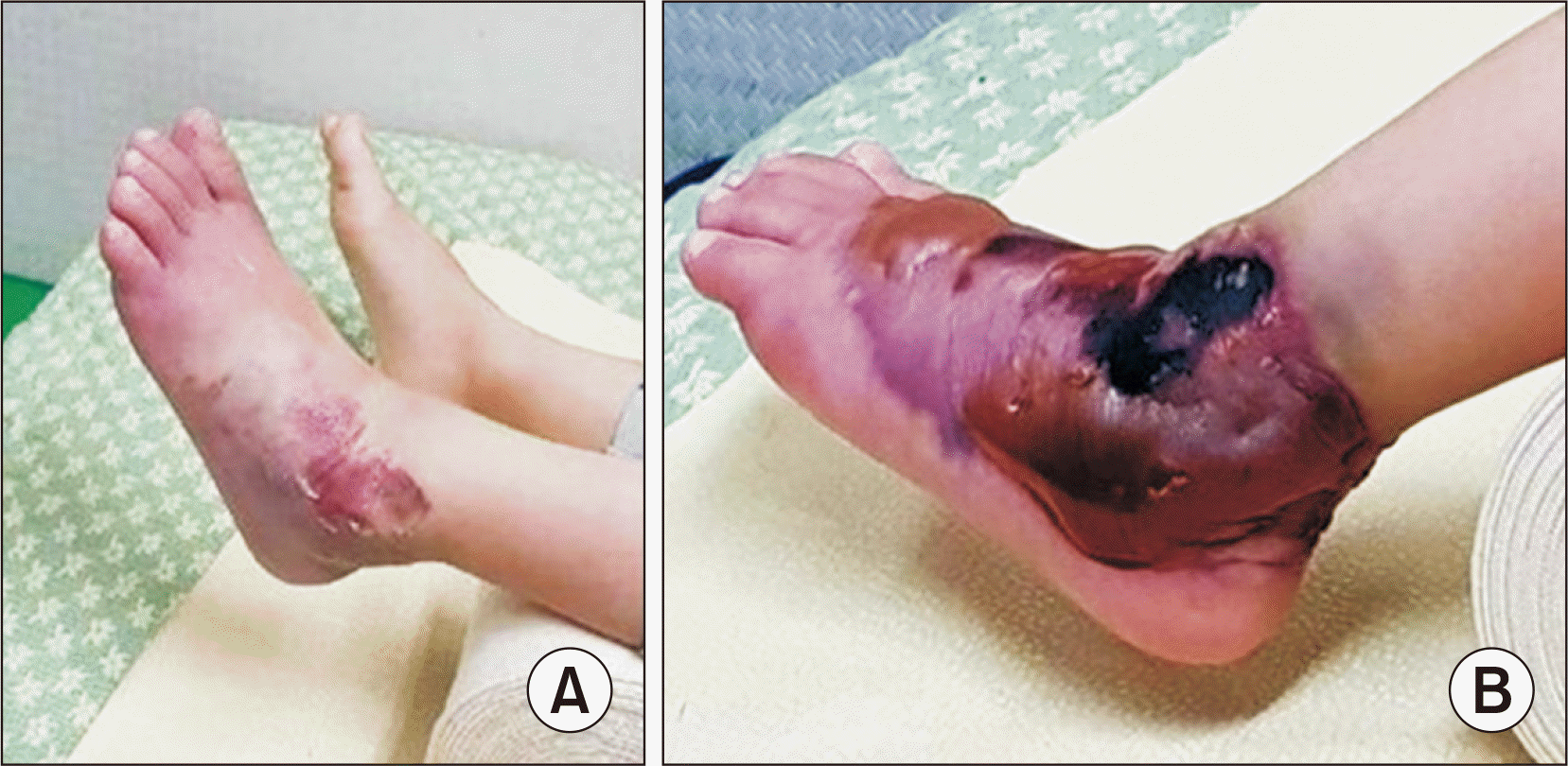 | Figure. 1Photographs show swelling and bullae of the left foot in the day of trauma (A) and the day after (B). 
|
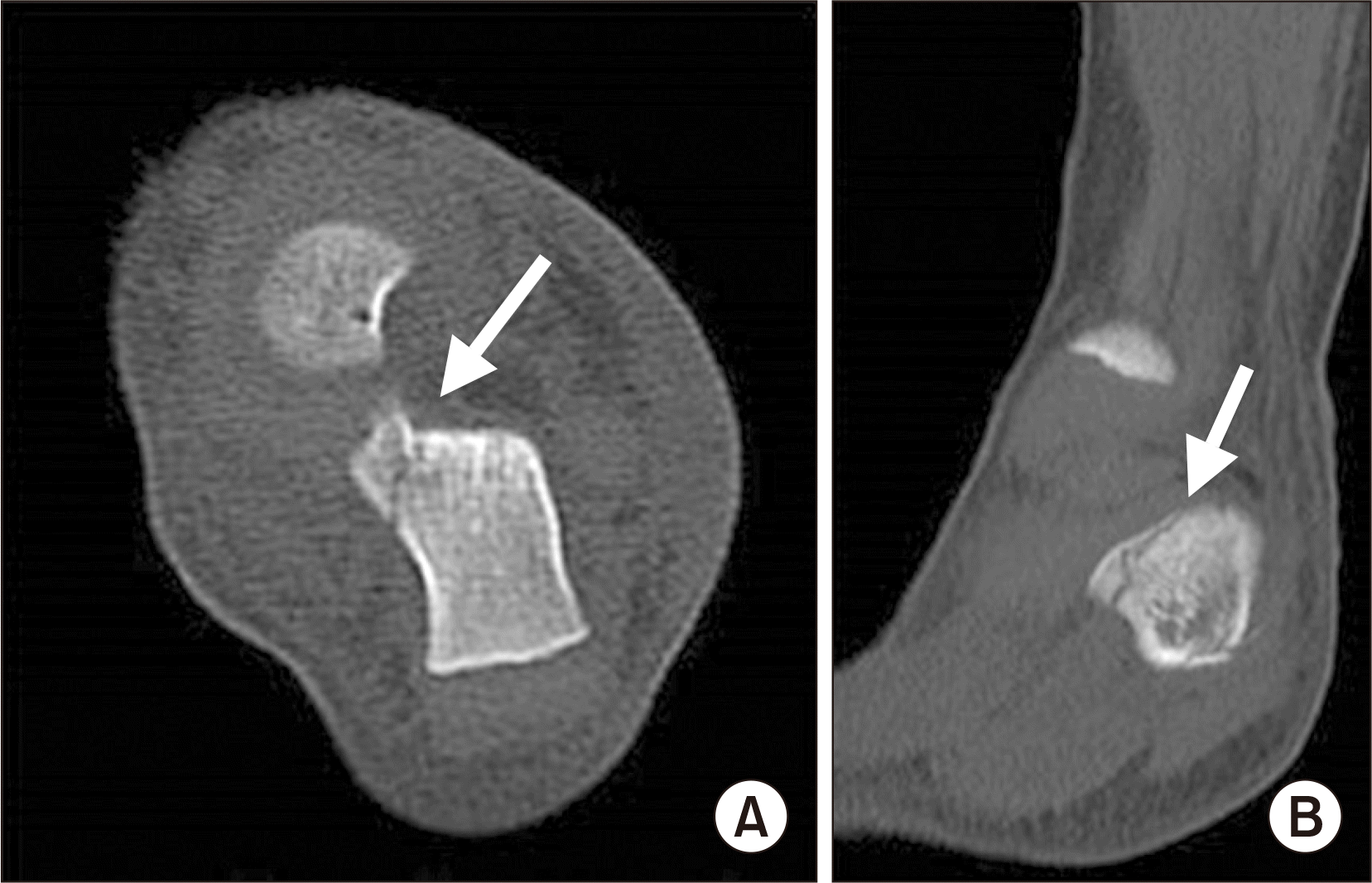 | Figure. 2The axial view (A) and the sagittal view (B) of computed tomography scan show fracture of the sustentaculum tali in the calcaneus (arrows). 
|
Therefore, the authors performed surgical treatment for delayed compartment syndrome based on clinical symptoms. Conservative treatment for delayed compartment syndrome may irreversibly accompany nerve damage, muscle necrosis, ischemic contracture, and renal dysfunction, but it may lower the incidence of infection and the amputation rate. On the other hand, if surgical treatment is performed, the incidence of infection and amputation may be high, but the incidence of nerve damage, muscle necrosis, ischemic contracture, and renal dysfunction may be reduced. Therefore, after discussing the treatment method, the authors performed emergency fasciotomy.
1-5)
Fasciotomy was performed with a dorsal approach and a medial plantar approach (
Fig. 3).
5) The incision was sterilized for 4 weeks and then split-skin graft was performed. Motor and sensory abilities were normal and follow-up was performed on an outpatient basis without additional complications of the lesion.
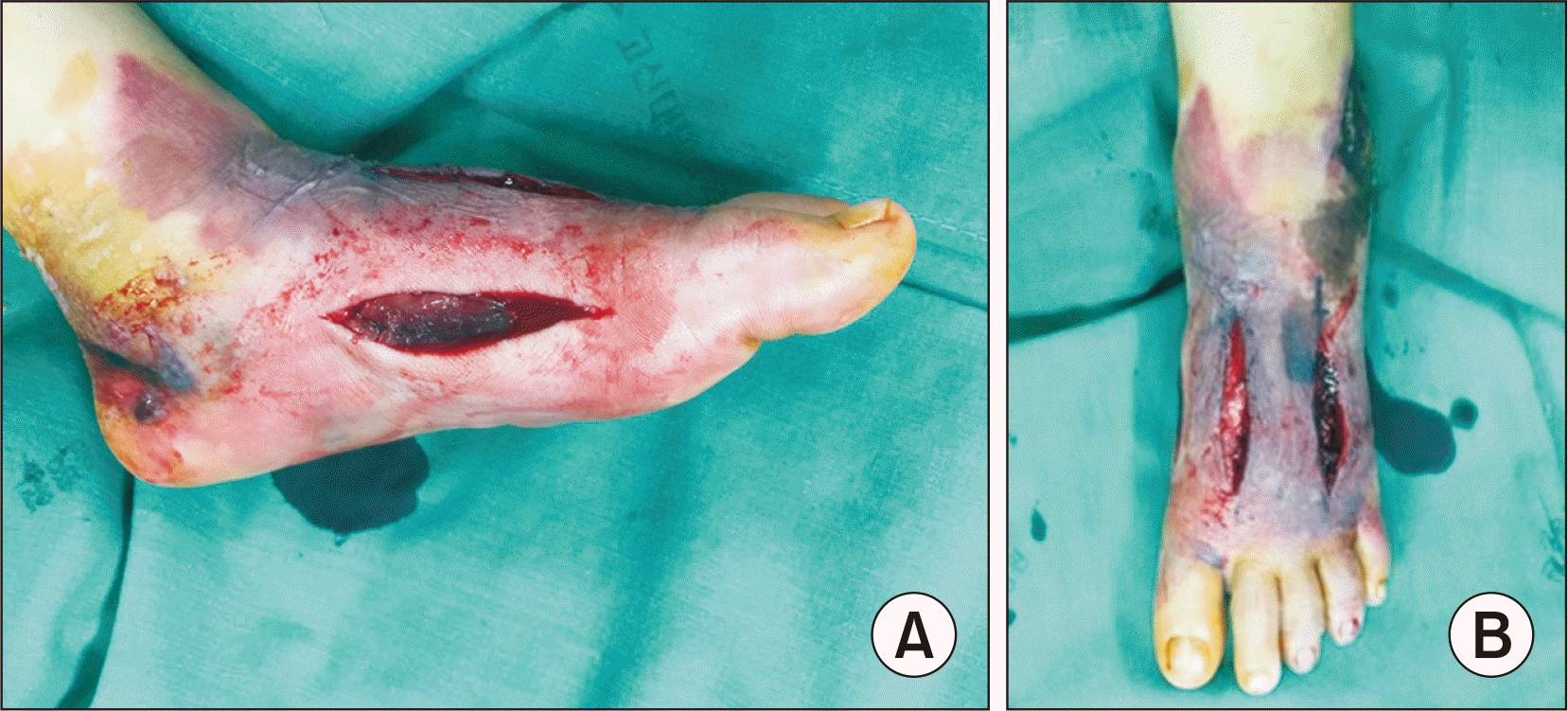 | Figure. 3The medial side (A) and the dorsal side (B) of intraoperative photographs show the left foot in which fasciotomy was done using dorsal and medial plantar approaches. 
|
The patient was in a delayed condition and clinical symptoms such as pain, pallor and clinically confirmed increased pressure, consistent with compartment syndrome. On five days after the injury, irreversible changes occurred to a significant extent in the affected site due to reduced blood flow (
Fig. 4). Ischemia was evident in the third, fourth, and fifth toes, and the possibility of an amputation as a treatment option had to be considered. Fasciotomy may be considered when the clinical symptoms and diagnosis of delayed compartment syndrome are clear, and patient recovery is expected. Since the dorsalis pedis artery pulse was palpable, an emergency surgical treatment was performed to restore the damaged tissues and to prevent further necrosis. The patient has shown a satisfactory recovery since then (
Fig. 5,
6).
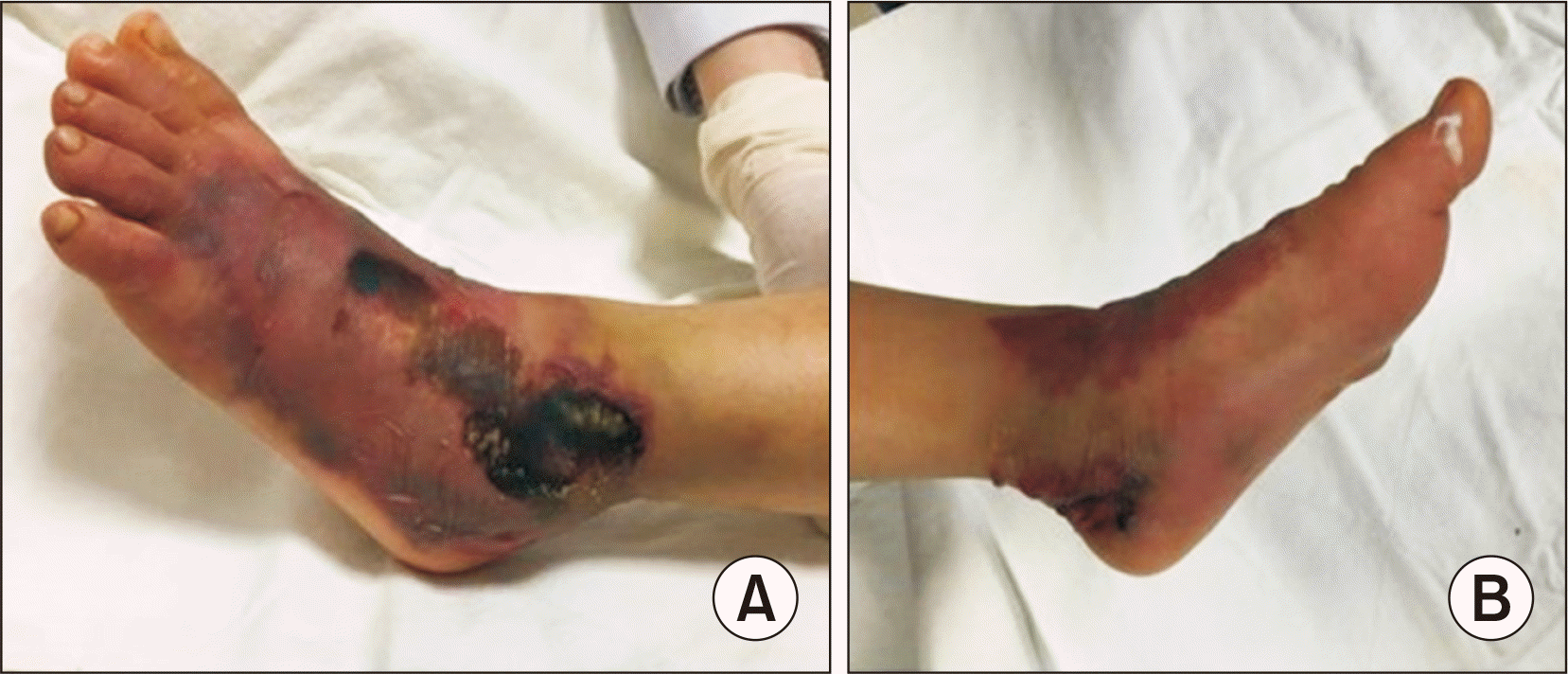 | Figure. 4The lateral side (A) and the medial side (B) of the left foot showing swelling, bullae 5 days after trauma. 
|
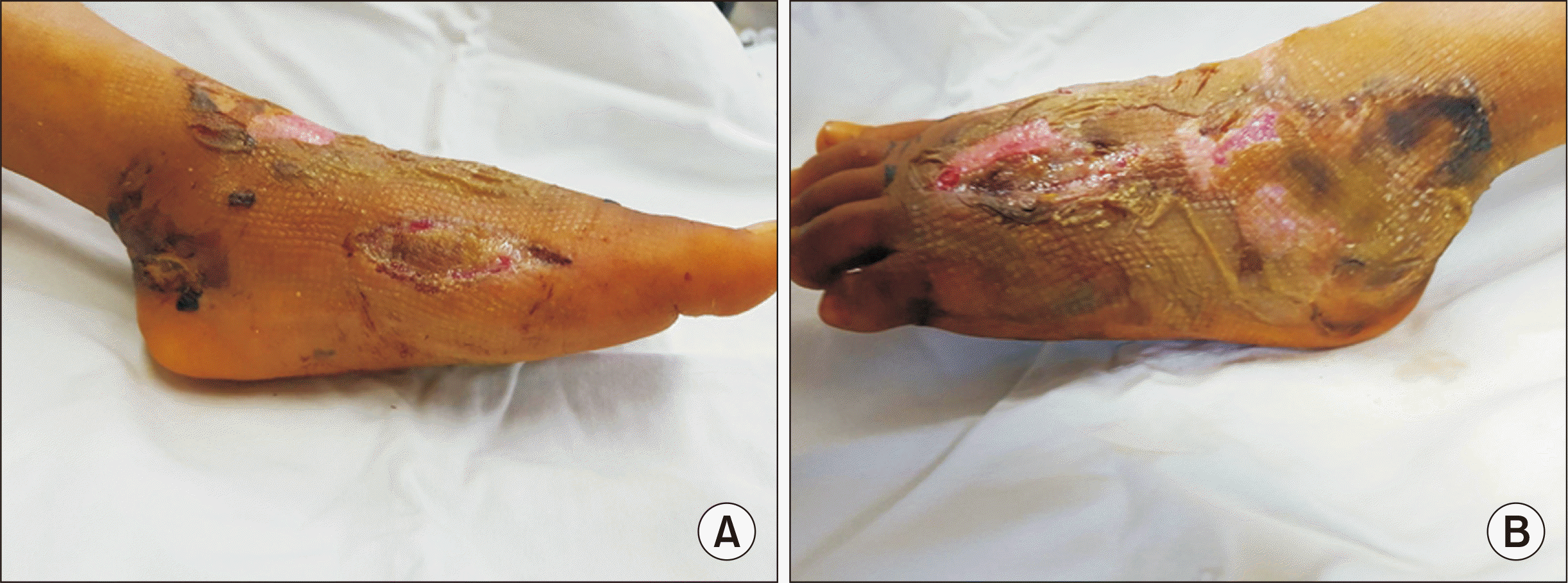 | Figure. 5The medial side (A) and the lateral side (B) of follow-up photographs show the left foot on 12 days after operation. 
|
 | Figure. 6The dorsal side (A), the medial side (B) and the lateral side (C) of follow-up photographs show the left foot at 58 days after operation. 
|
Even though several complications exist related to delayed compartment syndrome, fasciotomy was performed and the result was satisfactory considering the patient condition. Therefore, the delayed fasciotomy can be considered as a treatment option in special circumstances despite several risks of complications.
Go to :

DISCUSSION
It is necessary to carefully observe the clinical symptoms of a patient with acute compartment syndrome, which can be caused by fracture or crush injury. It is an orthopedic condition requiring emergency care and can lead to severe functional impairment if not treated promptly. For this reason, restoring the blood circulation through urgent depressurization can critically affect the prognosis of patients with acute compartment syndrome.
Compartment syndrome is a condition in which the microcirculatory flow is impaired and reduced below the amount of flow required for tissue survival due to an increased tissue pressure within the closed fascial compartments.
9)
The clinical symptoms of compartment syndrome include the 6 Ps: pain, paresthesia, paralysis, pallor, pulselessness, and poikilothermia. When these symptoms appear, compartment pressure must be measured for diagnosis, and after the diagnosis of compartment syndrome, an emergency fasciotomy is performed.
2)
However, delayed compartment syndrome is not an absolute indication for emergency fasciotomy if complete muscle necrosis due to Volkmann ischemic contracture are expected, then surgical excision of necrotic tissues must be considered following antibiotic and conservative treatment to prevent infections.
1)
Delayed fasciotomy cannot restore damaged nerves and muscles due to compartment syndrome. It instead converts a closed wound into an open wound. The skin must be conserved as it acts as a barrier against bacterial infections. Ernst and Kaufer
10) claimed that when a delayed fasciotomy is performed for compartment syndrome, exposed necrotic tissues act as a bacterial culture medium.
In addition, Reis and Better
8) claimed that it is not advisable to surgically treat lower limb compartment syndrome when treatment is delayed for over 24 hours until a boundary forms around the gangrenous area on the site of a closed crush injury, and that the condition is not an indication for widespread tissue necrosis or immediate surgical treatment. This is because a site of delayed fasciotomy shows a poorer progress regarding infection and amputation rate compared with muscle fibrosis.
Sheridan and Matsen
5) reported postoperative complication rates of 4.5% and 54% following early and delayed fasciotomies, respectively, and an infection rate of 46%, and an amputation rate of 21%, following the 12-hour delayed fasciotomy.
Go to :


